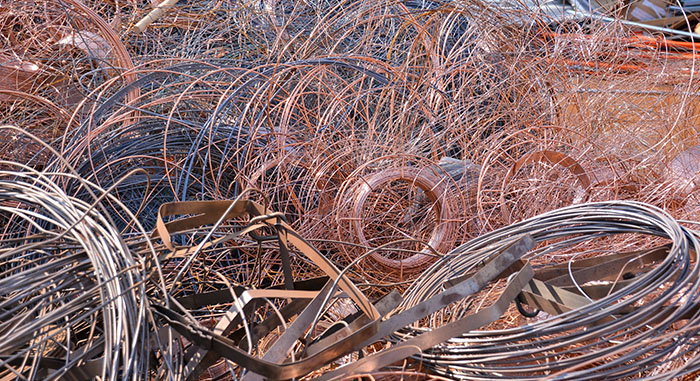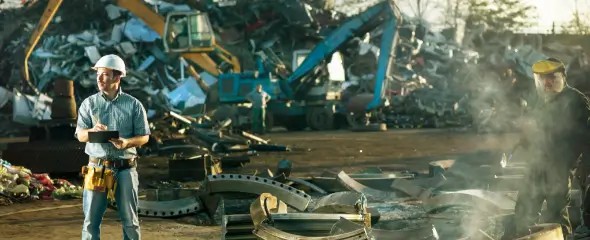
Copper is a soft metal with a reddish color & has an array of impressive uses with an infinitely recyclable life. It has innumerable applications & uses such as in electric motors, construction, industrial & everyday household products. If you collect copper scrap due to your profession, for example, a contractor, a construction or a demolition company, or if you do your own repairs, prior to selling copper scrap, it is helpful to know there are standard scrap copper grades recognized by the nonferrous metal recycling industry. The “grade” of copper refers to its value as recyclable metal. Value is based on two primary factors – the purity of copper scrap & the quantity of that copper recovered when it is eventually melted.
These grades were established by the metal recycling industry decades ago and are universally applied by scrap dealers in the United States, including H&C Metals, who buy copper scrap. The copper grading is largely influenced by the consumers (buyers) of copper scrap whom the dealers sell to. The “consumers” are a key component in the next stage of the recycling of copper because they receive the copper for smelting (melting), refining & repurposing.
The following are the most common copper grades, starting with the grade that is most valuable:
Bare Bright Copper
This type of copper is typically supplied by electricians and utility companies. Also known as bright & shiny copper, bare bright is 99.9% copper and is a highly targeted item for scrap dealers and their customers due to its high value. Additionally, it should not be thinner than 16-gauge in thickness size and be free of tarnish, oxidation, insulation, rubber or cloth residual, burnt wire, tinned, coated, plated, copper-clad (steel with copper exterior plating) and any other non-copper attachments. It’s useful to note that this type of copper is used to make power cables that deliver heavy voltage electricity into a building. Because Bare Bright comes from power cables, you will need to remove the insulation to generate bare bright copper.
# 1 Copper:
It is bare copper in the form of a tube, pipe, bus bar or some grades of wire that are not less than 1/16 of an inch in thickness. For example, the bus bar is used in transformers within large industrial buildings for transferring large amounts of electricity. Number one cooper should not have other metals attached to it, & be un-plated, un-coated & free of any contaminants. It is most commonly sold to H&C Metals in the form of a clean plumbing tube or pipe.
# 2 Copper:
Number 2 copper has a minimum of 94% copper content and may come in the form of bare bright with contamination and be tin-plated. Common examples of # 2 copper include piping, tubing, bus bar and some grades of thin gauge wire. It should be free of attachments such as brass, steel, die-cast, stainless steel, aluminum, Lead, etc., or other solid non-metallics such as insulation, foam, excessive oil & heavy sediment. Scrap dealers receive # 2 copper as plumbing scrap with solder, paint, a small percentage of grease or dirt, as well as enameled wire, oxidized copper, electric motor windings, copper-bearing, and tin-plated solids. It is common that # 2 copper is often supplied by plumbers, do-it-yourselfers, demolition contractors, electricians & mechanical & HVAC contractors.
Light Copper
This type of copper is sometimes referred to as “# 3 copper” & comes in the form of a thin gauge sheet & should have a minimum 92% copper content. A common example of a product that is in Light Copper form, is flashing– used on the base of a chimney to prevent water from seeping between the chimney & roofline. Other forms include sheet copper, gutters, downspouts, kettles, boilers & old fire extinguishers. Light copper should be free of excessively leaded, tinned, soldered scrap, brasses & bronzes, oil, iron, & reasonably free of tar.
The Copper Scrap Supplier to Dealer to Consumer Relationship
The majority of all copper-based metal products are reclaimed from scrap suppliers by scrap dealers (such as H&C Metals) as old metal and comes back into production due to recycling. The industries (“consumers”) through which a major part of these reclaimed copper products return to use are the brass & bronze ingot makers, brass & copper mills and the secondary smelters and refiners of copper. These industries heat & melt copper in a furnace into liquid form, from which it is poured into a cast to form an ingot—a block-shape, suitable for convenient shipping to the next step in the recycling process, where a manufacturer will re-melt the ingot & pour the liquid copper into a mold to create a new product, such as a water pipe sold to the plumbing industry or copper wire sold to the electrical industry.
How Copper Purity Affects Scrap Value
Regarding the purity of copper collected by scrap yards, copper can be free of other metals (unalloyed), or either chemically combined (alloyed) or plated with other metals, including Tin, Lead, Beryllium, Phosphorus & Silicon, etc., or contaminated by the presence of dirt, solder, paint, grease, oil, tape, enamel or fiber, etc. The value of copper scrap is affected by the cost associated with the melting process (described above). The purer the copper to be melted–the lower the cost to process it. The presence of other metals or non-metallics increases the cost of the melting process. During the melting stage, the process of separating various types of metals as well as contaminants to either recover metal or dispose of impurities results in higher operating costs for the consumer and a lower value assigned to the scrap.
Recovery in the Recycling Process
Recovery pertains to the amount of copper that solidifies after it’s been melted in a furnace. If 10,000 lbs. of copper scrap is added to a furnace of which 5% percent of the weight is solder or dirt & 5% of the copper evaporates while melting after the copper cools into solid material again, its recovery equates to 90%.
Recycle Your Copper Scrap with H&C Metals
Whether you have any of the above grades of copper, or other copper-bearing materials such as insulated wire/cable, electric motors, transformers, armatures & stators, feel free to consult with H&C Metals for accurate valuation purposes. We rely on 43 years of metal recycling expertise to correctly grade & price all forms of copper scrap.


